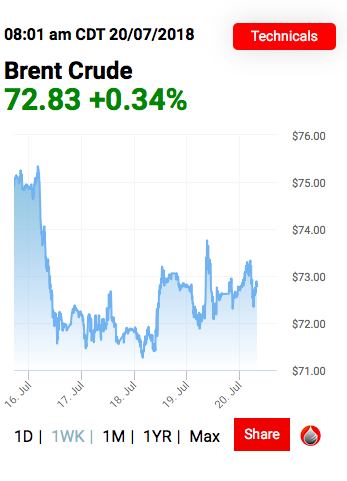Trump wanted lower oil prices prior to Iran sanctions and US midterm elections. He’s got them.
It’s been a rough ride for oil prices this week—culminating in the third-straight decline. And we can get back to the real fundamentals here: The trade war is causing demand to slow in both the US and China. Now, OPEC is saying that exports next month will be slowed a bit. The Saudis say exports will drop by 100,000 bpd next month to hedge against oversupply—a factor that slightly stabilized oil prices on Friday.
The one-week picture for Brent looked like this:
(Click to enlarge)
And for WTI:
(Click to enlarge)
Also tempering the oil price drop was the end of a strike Thursday by Norwegian drilling rig workers after 10 days.
At the same time, China’s Shanghai Futures Exchange (ShFE) has launched a new bonded fuel contract and by the close of the market on the day of the launch (July 16th), trading volume had reached 1.8 billion yuan (nearly $270 million). In March, China officially launched the trading of crude oil futures on the Shanghai International Energy Exchange, and Monday’s new contracts were the second since then. Major players are stepping up to the plate for this, including CNPC and Sinopec. Welcome to the third oil benchmark.
This all leads back to sanctions on Iran, the initial round which goes into effect on August 6, followed by another round to close it off on November 4. Tehran’s line of thinking is this:…
Trump wanted lower oil prices prior to Iran sanctions and US midterm elections. He’s got them.
It’s been a rough ride for oil prices this week—culminating in the third-straight decline. And we can get back to the real fundamentals here: The trade war is causing demand to slow in both the US and China. Now, OPEC is saying that exports next month will be slowed a bit. The Saudis say exports will drop by 100,000 bpd next month to hedge against oversupply—a factor that slightly stabilized oil prices on Friday.
The one-week picture for Brent looked like this:

(Click to enlarge)
And for WTI:

(Click to enlarge)
Also tempering the oil price drop was the end of a strike Thursday by Norwegian drilling rig workers after 10 days.
At the same time, China’s Shanghai Futures Exchange (ShFE) has launched a new bonded fuel contract and by the close of the market on the day of the launch (July 16th), trading volume had reached 1.8 billion yuan (nearly $270 million). In March, China officially launched the trading of crude oil futures on the Shanghai International Energy Exchange, and Monday’s new contracts were the second since then. Major players are stepping up to the plate for this, including CNPC and Sinopec. Welcome to the third oil benchmark.
This all leads back to sanctions on Iran, the initial round which goes into effect on August 6, followed by another round to close it off on November 4. Tehran’s line of thinking is this: China needs 500,000 bpd extra this year and another uptick close to that next year—figures they basing on IEA data. Iran is looking to fulfill this with Beijing running their payments through the Bank of Kunlun, whose exposure to the dollar is low. (They used this bank in the last sanctions sweep). Tehran sees China as significantly harming dollar liquidity by pricing oil imports in yuan.
China has too much to lose with regard to Iran, and not just in connection with importing Iranian crude. The sanctions have also given Beijing a bigger window of opportunity in Iran. When French Total gave up the massive South Pars gas project following Trump’s withdrawal from the nuclear deal, China’s state-run CNPC was happy to talk about stepping in. (On July 15, Total confirmed it had withdrawn from the project.)
Other oil politics issue of note this week:
• While everyone was busy this week berating Trump for weakness in the face of Russian President Vladimir Putin, there is an oil angle to these talks: Putin has offered to help Trump out with oil, as Trump seeks to lower oil prices by asking the Saudis to pump more. With its right hand, the Kremlin seeks to undermine U.S. oil and sanctions against itself and Iran; with its left, it offers to help regulate the oil markets. Russia’s oil designs particularly in Iran and Venezuela run counter to any idea of cooperation with the United States. Putin plays a long-term game, while Trump volleys immediate-term shots and waits to see what he hits. Following the disastrous meeting with Putin in Helsinki, Trump has now requested a second try with the Russian leader, inviting him to the US in the fall.
• In the meantime, Trump is toying with the idea of dipping further into the U.S. Strategic Petroleum Reserve (SPR) to help push down global oil prices and fill the gap from missing Iranian exports with sanctions in effect. More specifically, the Administration is talking about selling off anywhere between 5 million and 30 million barrels of the SPR, possibly even more if need be and depending on what other world oil producers agree to toss into the supply mix. Of course, just the mention of tapping into this much of the SPR caused oil prices to fall immediately, and that may be the game itself.
• Reports also suggest that Saudi Arabia is offering extra crude volumes to buyers in Asia, beyond contractual supplies, at the same time that China’s biggest trading arm is saying that it slashed Saudi crude purchases because of high prices. However, some reports have cited unnamed sources as saying that Aramco has offering up extra crude volumes of Arab Extra Light to two Asia buyers (possibly more) for August.
• July is expected to be a record production month for the Saudis.

(Click to enlarge)
At the same time, there is a risk to demand, with the IMF showing a slowdown in global economic growth.
Deals, Mergers & Acquisitions
• Tidewater and GulfMark Offshore agreed to merge in an all-stock transaction that will create the world’s largest global offshore service vessel operator, with the combined company valued at approximately $1.25 billion.
• Rival Japanese oil refiners Idemitsu Kosan and Showa Shell announced they will proceed with a long-delayed merger, clearing the way for a union in April 2019. The combined firm would account for about 30 percent of Japan’s domestic gasoline sales, second only to JXTG Holdings, which controls about half the market. Saudi Aramco owns a 14.96% stake in Showa.
• The planned sale of a majority stake in Greece’s Hellenic Petroleum is moving forward, with the authorities identifying to viable contenders: Glencore Energy UK Ltd and Vitol. While government sources say Vitol is the preferred choice in official corridors, Glencore could end up coming out on top if back channels decide they want to use this as a way to let Russia into the company, through the back door.
• China’s CNOOC has said it is preparing to invest another $3 billion in Nigeria’s offshore oil and gas. This would add to the some $14 billion CNOOC has already invested in Nigeria.
Tenders, Auctions & Contracts
• Myanmar will open up tenders for 13 offshore blocks by the end of this year in its first auction round since 2011.
• The US will hold an oil- and natural-gas-lease sale for the Gulf of Mexico in August, with BOEM offering up approximately 78 million acres offshore Texas, Louisiana, Mississippi, Alabama and Florida for exploration and development. The auction covers all available unleashed areas in the federal waters of the Gulf of Mexico.
Production, Discovery & Development
• Royal Dutch Shell has lifted force majeure (in place since May 17th) on Bonny Light following successful repairs on a pipeline feeding an export terminal. Two other grades, Forcados and Qua Iboe, have benefitted during the Bonny Light force majeure. Nigeria exported 1.796 million bpd in June, and July was expected to see a drop to 1.43 million bpd—which would be the lowest point this year.
• Alaska’s largest oil producer ConocoPhillips said it discovered up to 750 million barrels of oil equivalent (MMboe) of resources in the Greater Willow Area during its latest exploration and appraisal campaign. ConocoPhillips estimates development will cost between $2 billion to $3 billion over four to five years following a final investment decision, which is planned for 2021. First oil is possible as early as 2024.
• During the first half of July, Iraq exported oil at the fastest pace since late 2016, following the OPEC decision to ease production limits. Crude shipments during the first two weeks of the month were 4.05 MMbpd, the highest since November 2016. The daily average of exports for June was 6% lower. However, protests in the oil-rich southern provinces around Basra are threatening stability.
• Gazprom has announced that full-scale development of the Kharasaveyskoye field will begin in 2019. Kharasaveyskoye is located north of Bovanenkovskoye, mostly onshore in the Yamal Peninsula, but also stretching into the offshore Kara Sea basin. The field is said to contain an estimated two trillion cubic meters of gas.
Regulatory, Legal & Compliance
• The revival by US lawmakers in the Senate of legislation entitled “No Oil Producing and Exporting Cartels Act” (NOPEC) is said to have bipartisan support for a potential full vote this summer. The bill would remove OPEC shields from US antitrust measures, and OPEC is now seeking legal advice.
Politics, Geopolitics & Conflict
• Tullow Oil Plc has threatened to shut down operations in northern Kenya, at the prolific Lokichar basin, within two weeks if issues with local residents are not resolved. Residents are protesting profit-sharing and lack of security in the area. It is now up to the Kenyan government to come up with a resolution to allow oil field operations to restart. No work has been undertaken at Lokichar for about a month.
• While the US has indicated that it might consider exemptions from US sanctions for countries that are dependent on Iranian oil, the European Union’s request for an exemption has been rejected outright. South Korea is expected to apply for an exemption soon. Turkey has already said it would defy sanctions, and the EU is working on a number of measures to make it easier for companies to skirt sanctions.
• Libyan oil exports appear to have temporarily stabilized; however, this will only be a brief respite as the east-west tug-of-war over control of oil resources intensifies further. The latest round of this game has seen the Government of National Accord (GNA) promise General Haftar to look into allegations that the Central Bank is funding militia attacks against the General. Haftar, who has both freed and seized the country’s oil installations, has returned them to the NOC for now, but only because his external allies did not support his latest move to halt oil production as leverage to get oil-revenue-funded militias off his back.
• Amid mounting protests and social unrest and the struggle to form a new coalition government following May’s elections, Iraq has delayed the creation of its new national oil company, initially announced in March this year. The new NOC will now wait until a new government is formed, while the current government’s mandate expired on June 31.
• One of China’s largest independent oil refineries announced it will be switching from US crude to Iranian crude as the trade war continues to escalate. One of China’s largest independent oil refineries, ShanDong Dongming Petrochemical Group, announced that they had already canceled US crude orders. China’s Sinopec told media it plans to limit purchases of oil from the US and that it would instead increase imports from Iran. In late June, China announced plans to slap a 25-percent tariff on US crude oil in retaliation for American duties on Chinese goods. That has not come to fruition yet.

















